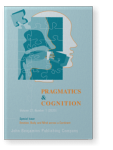Introduction published In:
Emotion, Body and Mind across a Continent: Figurative representations of emotions in Australian Aboriginal languagesEdited by Maïa Ponsonnet, Dorothea Hoffmann and Isabel O'Keeffe
[Pragmatics & Cognition 27:1] 2020
► pp. 1–19
